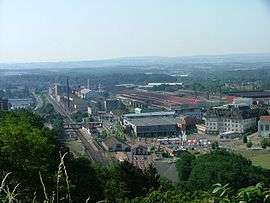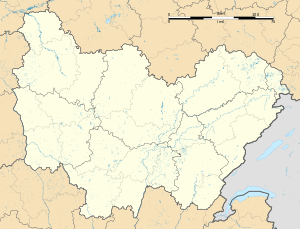Le Creusot
Le Creusot (pronounced [lə kʁøzo]) is a commune in the Saône-et-Loire department in the region of Bourgogne in eastern France.
Le Creusot | |
|---|---|
 Steel factory | |
.svg.png) Coat of arms | |
Location of Le Creusot 
| |
 Le Creusot  Le Creusot | |
| Coordinates: 46°48′05″N 4°26′28″E | |
| Country | France |
| Region | Bourgogne-Franche-Comté |
| Department | Saône-et-Loire |
| Arrondissement | Autun |
| Canton | Le Creusot-1 and 2 |
| Intercommunality | CU Creusot Montceau |
| Government | |
| • Mayor (2016–2020) | David Marti |
| Area 1 | 18.11 km2 (6.99 sq mi) |
| Population (2017-01-01)[1] | 21,630 |
| • Density | 1,200/km2 (3,100/sq mi) |
| Time zone | UTC+01:00 (CET) |
| • Summer (DST) | UTC+02:00 (CEST) |
| INSEE/Postal code | 71153 /71200 |
| Elevation | 316–516 m (1,037–1,693 ft) (avg. 347 m or 1,138 ft) |
| 1 French Land Register data, which excludes lakes, ponds, glaciers > 1 km2 (0.386 sq mi or 247 acres) and river estuaries. | |
The inhabitants are known as Creusotins. Formerly a mining town, its economy is now dominated by metallurgical companies such as ArcelorMittal, Schneider Electric, and Alstom.
Since the 1990s, the town has been developing its tourism credentials. Its main attraction is the Parc des Combes. The Creusot steam hammer is exposed as a tourist attraction in a square at the entrance to the town from the south.
Le Creusot is also the second educational centre of the Bourgogne (after Dijon), with its IUT and the Condorcet university centre.
History
In 1836, iron ore mines and forges around Le Creusot were bought by Adolphe Schneider and his brother Eugène Schneider. They developed a business in steel, railways, armaments, and shipbuilding. The Schneider empire developed much of the town itself, until it was much reduced in the second half of the twentieth century. It eventually became known as Schneider Electric. The steel forgings for the French nuclear power plants as well as the special alloys for the TGV trains were manufactured in Le Creusot.
On 17 October 1942 the Schneider factory was targeted by the RAF in a daylight raid designated Operation Robinson.
Transport
About 5 km (3.11 mi) south-east of town centre is the Gare du Creusot TGV, a train station on the LGV Sud-Est line, which links the area to Paris, Lyon and beyond with high-speed rail.
Sights
- Le pilon – 1877 steam hammer invented by François Bourdon

- Château de la Verrerie – Originally the Cristallerie royale of Queen Marie-Antoinette
Personalities
- André Billardon (b.1940), mayor
- Christian Bobin (b. 1951), writer
- François Bourdon (1797–1875), engineer and inventor of the steam hammer le pilon
- Fr. Bruno Cadoré (b. 1954), Dominican priest and current Master of the Order
- Mathilde Carré (1908–2007), French Resistance agent during World War II, who turned double agent
- Marie-Pierre Casey (b.1937) actress
- Jovan Deroko (1912–1941), Serbian Chetnik fighter during World War II
- Sébastien Grax (b. 1984), footballer
- Claudie Haigneré (b. 1957), astronaut
- Catherine Lépront (1951–2012), writer
- Adolphe Schneider (1802–1845), mine owner and entrepreneur
- Eugène Schneider (1805–1875), mine owner and entrepreneur
- Anthony da Silva (b. 1980), footballer
- Mickaël Vendetta (b. 1987), Internet celebrity
- John "Iron-Mad" Wilkinson (1728 – 1808) advised Le Creusot on the development of its iron industry
- Marie-Alice Yahé (b. 1984), female rugby player
International relations
Twin towns – sister cities
Le Creusot is twinned with: